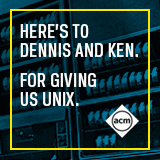Returning Control to the Programmer:
Exposing SIMD units within interpreted languages could simplify programs and unleash floods of untapped processor power.
Server and workstation hardware architecture is continually improving, yet interpreted languages have failed to keep pace with the proper utilization of modern processors. SIMD (single instruction, multiple data) units are available in nearly every current desktop and server processor and are greatly underutilized, especially with interpreted languages. If multicore processors continue their current growth pattern, interpreted-language performance will begin to fall behind, since current native compilers and languages offer better automated SIMD optimization and direct SIMD mapping support.
A Conversation with James Gosling:
James Gosling talks about virtual machines, security, and of course, Java.
As a teenager, James Gosling came up with an idea for a little interpreter to solve a problem in a data analysis project he was working on at the time. Through the years, as a grad student and at Sun as creator of Java and the Java Virtual Machine, he has used several variations on that solution. “I came up with one answer once, and I have just been repeating it over and over again for a frightening number of years,” he says.
Toolkit: Samba Does Windows-to-Linux Dance:
Mounting remote Linux drives under Windows is easier than you think.
With heterogeneous networked environments becoming the rule rather than the exception, there’s more need than ever for Windows and Linux to work and play well together. Enter Samba, the print- and file-sharing tool that enables files residing on Linux hosts to interact with Windows-based desktops.
Simulators: Virtual Machines of the Past (and Future):
Has the time come to kiss that old iron goodbye?
Simulators are a form of “virtual machine” intended to address a simple problem: the absence of real hardware. Simulators for past systems address the loss of real hardware and preserve the usability of software after real hardware has vanished. Simulators for future systems address the variability of future hardware designs and facilitate the development of software before real hardware exists.
Building Systems to Be Shared, Securely:
Want to securely partition VMs? One option is to put ’em in Jail.
The history of computing has been characterized by continuous transformation resulting from the dramatic increases in performance and drops in price described by Moore’s law. Computing power has migrated from centralized mainframes/servers to distributed systems and the commodity desktop. Despite these changes, system sharing remains an important tool for computing. From the multitasking, file-sharing, and virtual machines of the desktop environment to the large-scale sharing of server-class ISP hardware in collocation centers, safely sharing hardware between mutually untrusting parties requires addressing critical concerns of accidental and malicious damage.
Building Systems to Be Shared, Securely:
Want to securely partition VMs? One option is to put ’em in Jail.
The history of computing has been characterized by continuous transformation resulting from the dramatic increases in performance and drops in price described by Moore’s law. Computing power has migrated from centralized mainframes/servers to distributed systems and the commodity desktop. Despite these changes, system sharing remains an important tool for computing. From the multitasking, file-sharing, and virtual machines of the desktop environment to the large-scale sharing of server-class ISP hardware in collocation centers, safely sharing hardware between mutually untrusting parties requires addressing critical concerns of accidental and malicious damage.
The Reincarnation of Virtual Machines:
Virtualization makes a comeback.
The term virtual machine initially described a 1960s operating system concept: a software abstraction with the looks of a computer system’s hardware (real machine). Forty years later, the term encompasses a large range of abstractions?for example, Java virtual machines that don’t match an existing real machine. Despite the variations, in all definitions the virtual machine is a target for a programmer or compilation system. In other words, software is written to run on the virtual machine.






